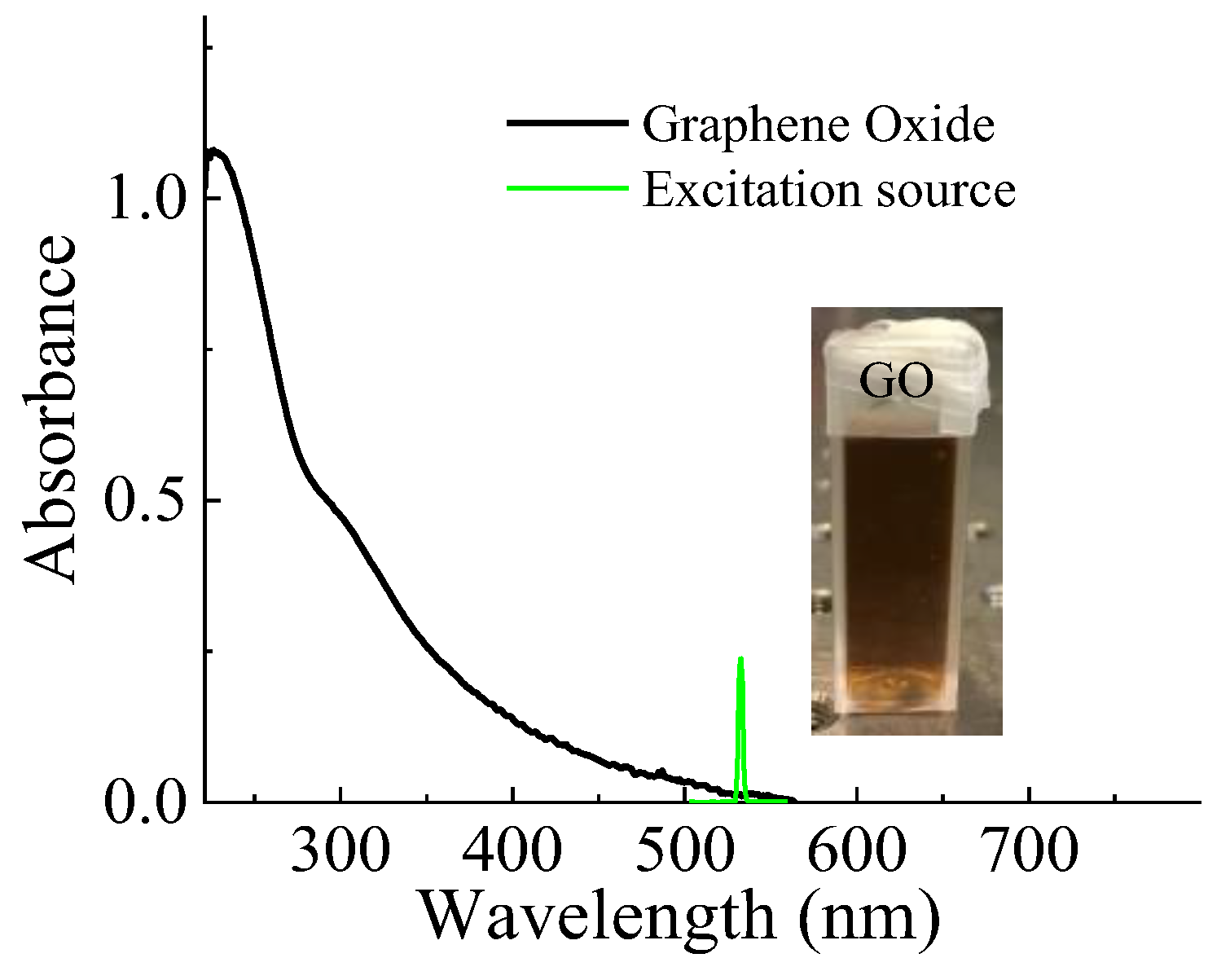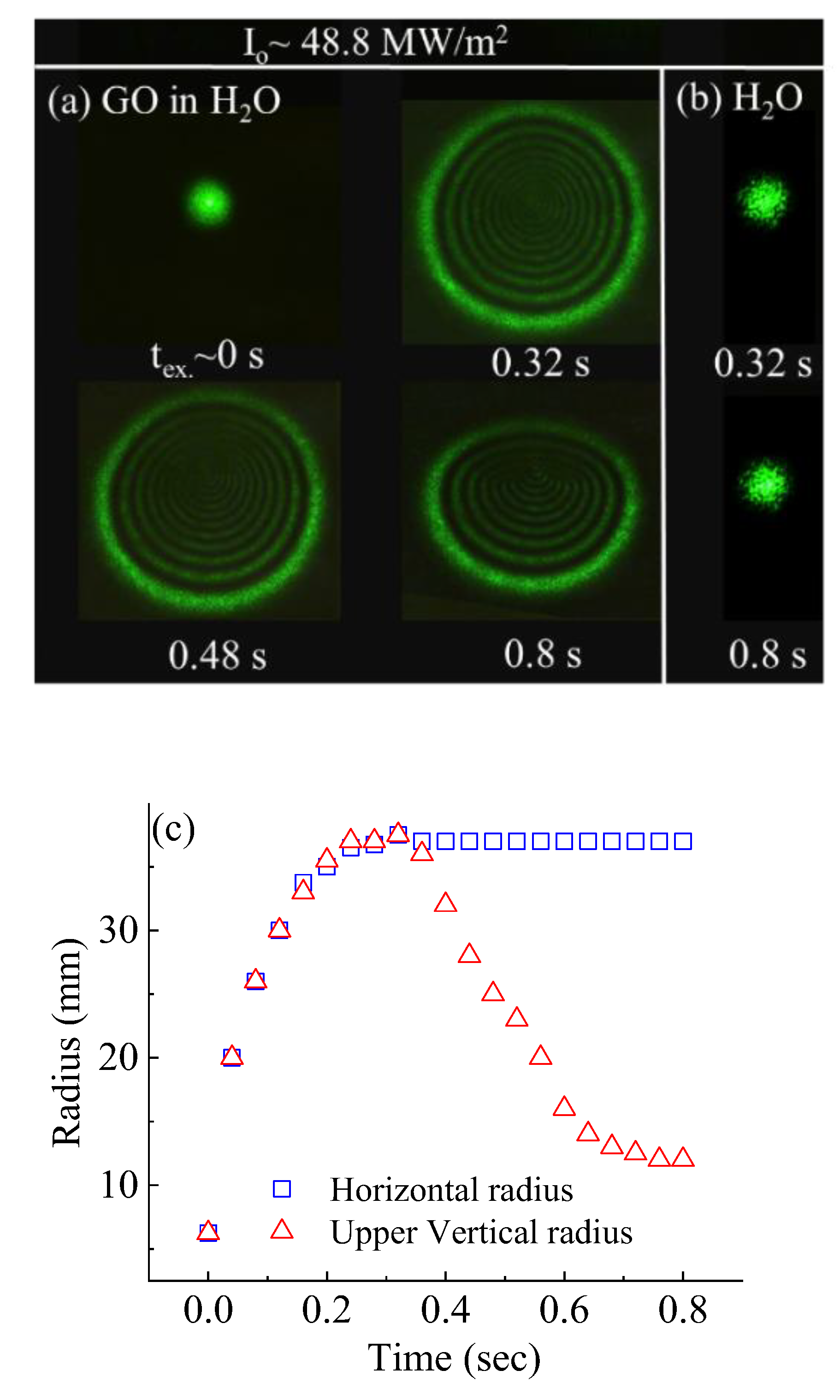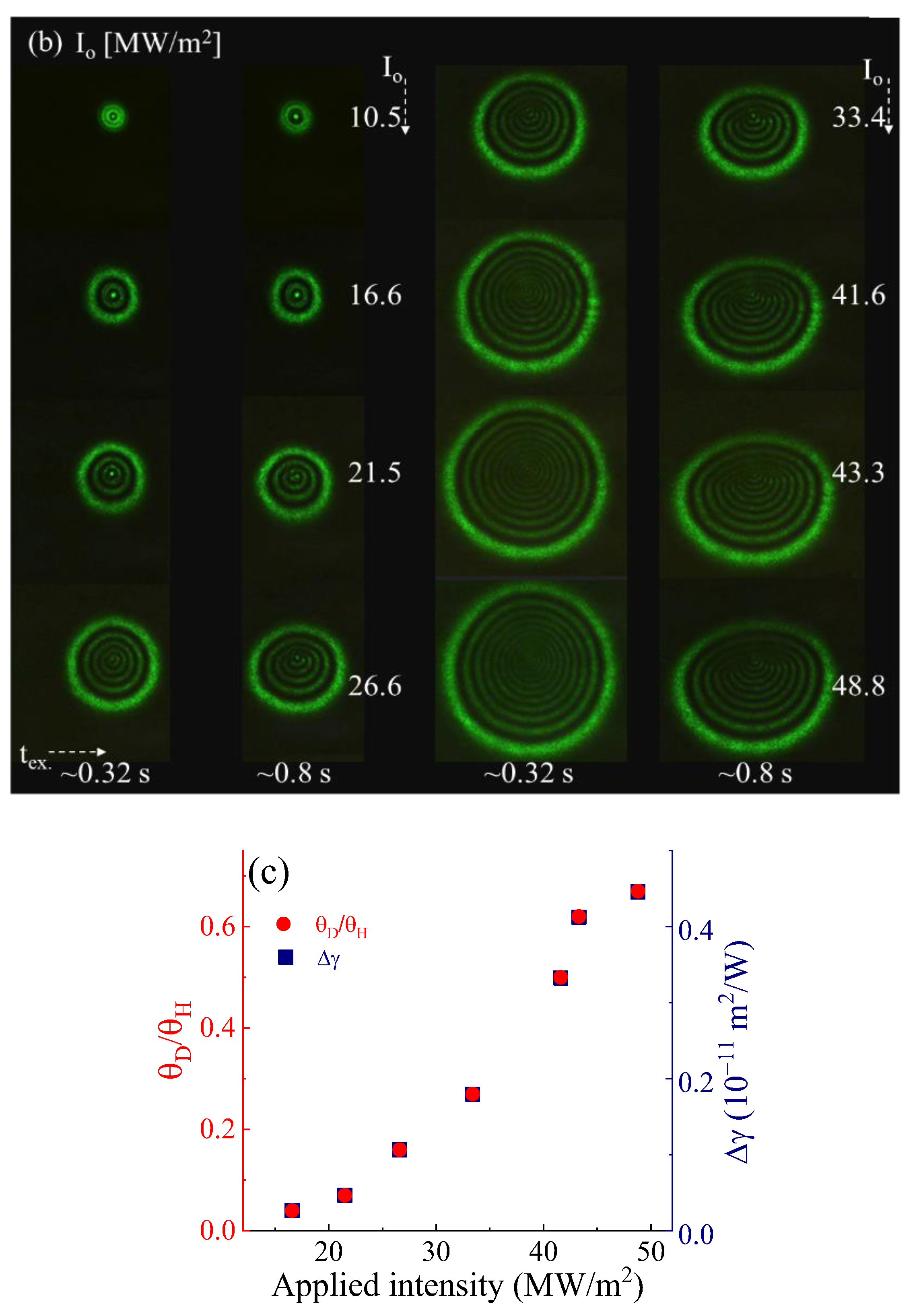Spatial Self-Phase Modulation in Graphene-Oxide Monolayer
Abstract
:1. Introduction
2. Materials and Methods
3. Result and Discussion
4. Conclusions
Author Contributions
Funding
Data Availability Statement
Conflicts of Interest
References
- Neupane, T.; Yu, S.; Rice, Q.; Tabibi, B.; Seo, F.J. Third-order optical nonlinearity of tungsten disulfide atomic layer with resonant excitation. Opt. Mat. 2019, 96, 109271. [Google Scholar] [CrossRef]
- Jiang, X.F.; Polavarapu, L.; Neo, S.T.; Venkatesan, T.; Xu, Q.H. Graphene Oxides as Tunable Broadband Nonlinear Optical Materials for Femtosecond Laser Pulses. J. Phys. Chem. Lett. 2012, 3, 785–790. [Google Scholar] [CrossRef] [PubMed]
- Chantharasupawong, P.; Philip, R.; Narayanan, N.T.; Sudeep, P.M.; Mathkar, A.; Ajayan, P.M.; Thomas, J. Optical Power Limiting in Fluorinated Graphene Oxide: An Insight into the Nonlinear Optical Properties. J. Phys. Chem. C 2012, 116, 25955–25961. [Google Scholar] [CrossRef]
- Xu, X.; Zheng, X.; He, F.; Wang, Z.; Subbaraman, H.; Wang, Y.; Jia, B.; Chen, R.T. Observation of Third-order Nonlinearities in Graphene Oxide Film at Telecommunication Wavelengths. Sci. Rep. 2017, 7, 9646. [Google Scholar] [CrossRef] [PubMed]
- Krishna, M.B.M.; Venkatramaiah, N.; Venkatesan, R.; Rao, D.N. Synthesis and structural, spectroscopic, and nonlinear optical measurements of graphene oxide and its composites with metal and metal free porphyrins. J. Mater. Chem. 2012, 22, 3059. [Google Scholar] [CrossRef]
- Shan, Y.; Tang, J.; Wu, L.; Lu, S.; Dai, X.; Xiang, Y. Spatial self-phase modulation and all-optical switching of graphene oxide dispersions. J. Alloys Compd. 2019, 771, 900–904. [Google Scholar] [CrossRef]
- Yan, Z.; Yang, H.; Yang, Z.; Ji, C.; Zhang, G.; Tu, Y.; Du, G.; Cai, S.; Lin, S. Emerging Two-Dimensional Tellurene and Tellurides for Broadband Photodetectors. Small 2022, 18, 2200016. [Google Scholar] [CrossRef]
- Strauss, F.; Payandeh, S.; Kondrakov, A.; Brezesinski, T. On the role of surface carbonate species in determining the cycling performance of all-solid-state batteries. Mater. Futur. 2022, 1, 032302. [Google Scholar] [CrossRef]
- Weng, W.; Zhou, D.; Liu, G.; Shen, L.; Li, M.; Chang, X.; Yao, X. Air exposure towards stable Li/Li10GeP2S12 interface for all-solid-state lithium batteries. Mater Futur. 2022, 1, 012301. [Google Scholar] [CrossRef]
- Yu, W.; Gong, K.; Li, Y.; Ding, B.; Li, L.; Xu, Y.; Wang, R.; Li, L.; Zhang, G.; Lin, S. Flexible 2D Materials beyond Graphene: Synthesis, Properties, and Applications. Small 2022, 18, 2105383. [Google Scholar] [CrossRef]
- Yu, S.; Rice, Q.; Neupane, T.; Tabibi, B.; Li, Q.; Seo, F.J. Piezoelectricity enhancement and bandstructure modification of atomic defect mediated MoS2 monolayer. Phys. Chem. Chem. Phys. 2017, 19, 24271–24275. [Google Scholar] [CrossRef] [PubMed]
- Sheik-bahae, M.; Said, A.A.; Van Stryland, E.V. High-sensitivity single- beam n2 measurements. Opt. Lett. 1998, 14, 955–957. [Google Scholar] [CrossRef]
- Zheng, X.; Zhang, Y.; Chen, R.; Cheng, X.; Xu, Z.; Jiang, T. Z-scan measurement of the nonlinear refractive index of monolayer WS2. Opt. Express 2015, 23, 15616–15623. [Google Scholar] [CrossRef] [PubMed]
- Ma, S.M.; Seo, J.T.; Yang, Q.; Creemore, L.; Battle, R.; Tabibi, B.; Yu, W. Polarization-resolved degenerate four-wave mixing of CdS nanocrystals in a nonresonant region. Phys. Status Solidi C 2006, 3, 3488–3491. [Google Scholar] [CrossRef]
- Neupane, T.; Wang, H.; William, W.Y.; Tabibi, B.; Seo, F.J. Second-order hyperpolarizability and all-optical-switching of intensity-modulated spatial self-phase modulation in CsPbBr1.5I1.5 perovskite quantum dot. Opt. Laser Technol. 2021, 140, 107090. [Google Scholar] [CrossRef]
- Neupane, T.; Rice, Q.; Jung, S.; Tabibi, B.; Seo, F.J. Cubic Nonlinearity of Molybdenum Disulfide Nanoflakes. J. Nanosci. Nanotechnol. 2020, 20, 4373–4375. [Google Scholar] [CrossRef]
- Seo, J.T.; Ma, S.M.; Yang, Q.; Creekmore, L.; Battle, R.; Brown, H.; Jackson, A.; Skyles, T.; Tabibi, B.; Yu, W.; et al. Large resonant third-order optical nonlinearity of CdSe nanocrystal quantum dots. J. Phys. Conf. Ser. 2006, 38, 91–94. [Google Scholar] [CrossRef]
- Yu, S.; Neupane, T.; Tabibi, B.; Li, Q.; Seo, F.J. Spin-Resolved Visible Optical Spectra and Electronic Characteristics of Defect-Mediated Hexagonal Boron Nitride Monolayer. Crystal 2022, 12, 906. [Google Scholar] [CrossRef]
- Shan, Y.; Li, Z.; Ruan, B.; Zhu, J.; Xiang, Y.; Dai, X. Two-dimensional Bi2S3-based all-optical photonic devices with strong nonlinearity due to spatial self-phase modulation. Nanophotonics 2019, 8, 2225–2234. [Google Scholar] [CrossRef]
- Lu, L.; Wang, W.; Wu, L.; Jiang, X.; Xiang, Y.; Fan, D.; Zhang, H. All optical switching of two continuous waves in few layer bismuthene based on spatial cross-phase modulation. Photonics 2017, 4, 2852–2861. [Google Scholar] [CrossRef]
- Shan, Y.; Wu, L.; Liao, Y.; Tang, J.; Dai, X.; Xiang, Y. A promising nonlinear optical material and its applications for all-optical switching and information converters based on the spatial self-phase modulation (SSPM) effect of TaSe2 nanosheets. J. Mater. Chem. C 2019, 7, 3811–3816. [Google Scholar] [CrossRef]
- Callen, W.R.; Huth, B.G.; Pantell, R.H. Optical Patterns of Thermally Self-Defocused Light. Appl. Phys. Lett. 1967, 11, 103. [Google Scholar] [CrossRef]
- Cheng, L.; Zhang, Z.; Zhang, L.; Ma, D.; Yang, G.; Dong, T.; Zhang, Y. Manipulation of a ring-shaped beam via spatial self- and cross-phase modulation at lower intensity. Phys. Chem. Chem. Phys. 2019, 21, 7618. [Google Scholar] [CrossRef] [PubMed]
- Wu, J.J.; Chen, S.H.; Fan, J.Y.; Ong, G.S. Propagation of a Gaussian-profile laser beam in nematic liquid crystals and the structure of its nonlinear diffraction rings. J. Opt. Soc. Am. B 1990, 7, 1147. [Google Scholar] [CrossRef]
- Durbin, S.D.; Arakelian, S.M.; Shen, Y.R. Laser-induced diffraction rings from a nematicliquid-crystal film. Opt. Lett. 1981, 6, 411–413. [Google Scholar] [CrossRef]
- Wang, Y.; Tang, Y.; Cheng, P.; Zhou, X.; Zhu, Z.; Liu, Z.; Liu, D.; Wang, Z.; Bao, J. Distinguishing thermal lens effect from electronic third-order nonlinear self-phase modulation in liquid suspensions of 2D nanomaterials. Nanoscale 2017, 9, 3547–3554. [Google Scholar] [CrossRef]
- Sadrolhosseini, A.R.; Suraya Abdul Rashid, S.A.; Shojanazeri, H.; Noor, A.S.M.; Nezakati, H. Spatial self-phase modulation patterns in graphene oxide and graphene oxide with silver and gold nanoparticles. Opt. Quantum Electron. 2016, 48, 222. [Google Scholar] [CrossRef]
- Coleman, J.N.; Khan, U.; Young, K.; Gaucher, A.; De, S.; Smith, R.J.; Shvets, I.V.; Arora, S.K.; Stanton, G.; Kim, H.; et al. Two-Dimensional Nanosheets Produced by Liquid Exfoliation of Layered Materials. Science 2011, 331, 568–571. [Google Scholar] [CrossRef]
- Wang, G.; Zhang, S.; Zhang, X.; Zhang, L.; Cheng, Y.; Fox, D.; Zhang, H.; Coleman, J.N.; Blau, W.J.; Wang, J. Tunable nonlinear refractive index of two-dimensional MoS2, WS2, and MoSe2 nanosheet dispersions. Photon. Res. 2015, 3, A51–A55. [Google Scholar] [CrossRef]
- Wu, Y.L.; Zhu, L.L.; Wu, Q.; Sun, F.; Wei, J.K.; Tian, Y.C.; Wang, W.L.; Bai, X.D.; Zuo, X.; Zhao, J. Electronic origin of spatial self-phase modulation: Evidenced by comparing graphite with C60 and graphene. Appl. Phys. Lett. 2016, 108, 241110. [Google Scholar] [CrossRef]
- Wu, Y.; Wu, Q.; Sun, F.; Cheng, C.; Meng, S.; Zhao, J. Emergence of electron coherence and two-color all-optical switching in MoS2 based on spatial self-phase modulation. Proc. Natl. Acad. Sci. USA 2015, 112, 11800–11805. [Google Scholar] [CrossRef] [PubMed]
- Wu, R.; Zhang, Y.; Yan, S.; Bian, F.; Wang, W.; Bai, X.; Lu, X.; Zhao, J.; Wang, E. Purely coherent nonlinear optical response in solution dispersions of graphene sheets. Nano. Lett. 2011, 11, 5159–5164. [Google Scholar] [CrossRef] [PubMed]
- Wang, Z. Alignment of graphene nanoribbons by an electric field. Carbon 2009, 47, 3050–3053. [Google Scholar] [CrossRef]
- Wang, G.; Higgins, S.; Wang, K.; Bennett, D.; Milosavljevic, N.; Magan, J.J.; Zhang, S.; Zhang, X.; Wang, J.; Blau, W.J. Intensity-dependent nonlinear refraction of antimonene dispersions in the visible and near-infrared region. App. Opt. 2018, 57, E147–E153. [Google Scholar] [CrossRef] [PubMed]
- Karimzadeh, R. Spatial Self-Phase Modulation of a laser beam propagation through liquids with self-induced natural convection flow. J. Opt. 2012, 14, 95701. [Google Scholar] [CrossRef]
- Geints, Y.E.; Panamarev, N.S.; Zemlyanov, A.A. Transient behavior of far-field diffraction patterns of a Gaussian laser beam due to the thermo-optical effect in metal nano-colloids. J. Opt. 2011, 13, 55707. [Google Scholar] [CrossRef]
- Neupane, T.; Tabibi, B.; Seo, F.J. Spatial Self-Phase Modulation in WS2 and MoS2 Atomic Layers. Opt. Mat. Express 2020, 10, 831–842. [Google Scholar] [CrossRef]
- Zhang, Q.; Cheng, X.; Zhang, Y.; Yin, X.; Jiang, M.; Chen, H.; Bai, J. Optical limiting using spatial self-phase modulation in hot atomic sample. Opt. Laser Technol. 2017, 88, 54–60. [Google Scholar] [CrossRef]
- Khoo, I.C.; Hou, J.Y.; Liu, T.H.; Yan, P.Y.; Michael, R.R.; Finn, G.M. Transverse self-phase modulation and bistability in the transmission of a laser beam through a nonlinear thin film. J. Opt. Soc. Am. B 1987, 4, 886–891. [Google Scholar] [CrossRef]
- Myint, T.; Alfano, R.R. Spatial phase modulation from permanent memory in doped glass. Opt. Lett. 2010, 35, 1275–1277. [Google Scholar] [CrossRef]
- Harrison, R.G.; Dambly, L.; Yu, D.; Lu, W. A new self-diffraction pattern formation in defocusing liquid media. Opt. Commun. 1997, 139, 69–72. [Google Scholar] [CrossRef]
- Vest, C.M.; Lawson, M.L.; Arbor, A. Onset of Convection near a Suddenly Heated Horizontal Wire. Int. J. Heat Mass. Transf. 2012, 15, 1281–1283. [Google Scholar] [CrossRef]
- Jia, Y.; Shan, Y.; We, L.; Dai, S.; Fan, D.; Xiang, Y. Broadband nonlinear optical resonance and all-optical switching of liquid phase exfoliated tungsten diselenide. Photon. Res. 2018, 6, 1040–1047. [Google Scholar] [CrossRef]






Disclaimer/Publisher’s Note: The statements, opinions and data contained in all publications are solely those of the individual author(s) and contributor(s) and not of MDPI and/or the editor(s). MDPI and/or the editor(s) disclaim responsibility for any injury to people or property resulting from any ideas, methods, instructions or products referred to in the content. |
© 2023 by the authors. Licensee MDPI, Basel, Switzerland. This article is an open access article distributed under the terms and conditions of the Creative Commons Attribution (CC BY) license (https://creativecommons.org/licenses/by/4.0/).
Share and Cite
Neupane, T.; Tabibi, B.; Kim, W.-J.; Seo, F.J. Spatial Self-Phase Modulation in Graphene-Oxide Monolayer. Crystals 2023, 13, 271. https://doi.org/10.3390/cryst13020271
Neupane T, Tabibi B, Kim W-J, Seo FJ. Spatial Self-Phase Modulation in Graphene-Oxide Monolayer. Crystals. 2023; 13(2):271. https://doi.org/10.3390/cryst13020271
Chicago/Turabian StyleNeupane, Tikaram, Bagher Tabibi, Wan-Joong Kim, and Felix Jaetae Seo. 2023. "Spatial Self-Phase Modulation in Graphene-Oxide Monolayer" Crystals 13, no. 2: 271. https://doi.org/10.3390/cryst13020271
APA StyleNeupane, T., Tabibi, B., Kim, W.-J., & Seo, F. J. (2023). Spatial Self-Phase Modulation in Graphene-Oxide Monolayer. Crystals, 13(2), 271. https://doi.org/10.3390/cryst13020271







